Revolutionizing customer satisfaction: Unveiling the secrets of NPS tools
Published on September 01, 2023 - Updated on December 05, 2023
Revolutionizing customer satisfaction: Unveiling the secrets of NPS tools
1) Understanding the Net Promoter Score
Imagine eating your favorite dish at a restaurant when suddenly, the waiter asks you, "On a scale of 0 to 10, how likely are you to recommend this restaurant to your friends?" Behind this simple question lies a powerful tool for measuring customer satisfaction.
📖 Definition of NPS
The Net Promoter Score (NPS) acts as a thermometer measuring customer satisfaction. By assigning a number from 0 to 10 to your experience in response to this question, you are categorized into one of three groups:
Detractors (Score 0-6): A low score indicates an unsatisfactory experience. You probably wouldn't actively recommend the restaurant.
Passives (Score 7-8): An average score indicates a satisfactory but improvable experience. You might say "yes" if asked whether you enjoyed the restaurant, but wouldn't actively recommend it.
Promoters (Score 9-10): A high score indicates more than just satisfaction. You would definitely recommend this restaurant to friends and family.
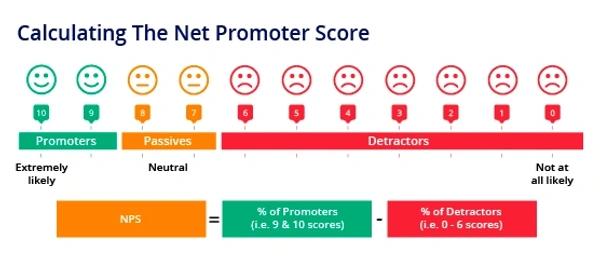
A brief history of NPS
The idea of NPS was conceived in 2003 by Fred Reichheld. He realized that this simple question, "Would you recommend?", could help businesses quickly understand whether customers were satisfied or not. Since then, NPS has become highly popular due to its user-friendly nature and applicability across all types of businesses.
Why NPS matters
Now, you might be wondering, "Why is it important to know if people would recommend a restaurant or a business?" Well, imagine every time you have a delicious meal, you talk about that restaurant to your friends. Then, your friends decide to try it. It's like a chain of recommendations that helps the restaurant grow.
Similarly, businesses use NPS to measure how customers feel about them. Promoters help attract new customers by encouraging them to try what the company offers. Passives indicate that things are going well but there's still room for improvement. Finally, detractors signal potential issues that need to be resolved to keep customers happy.
2) Different types of NPS
📖 Relational NPS
Imagine you're painting a picture representing your entire relationship with a company. Relational NPS is an indicator that captures this overall picture by measuring customers' perception of the brand over an extended period. Instead of focusing on a single transaction, this type of NPS explores how customers feel about their overall experience with the company over a certain timeframe.
📖 Transactional NPS
Now, consider a snapshot, a zoom-in on a specific interaction. Transactional NPS focuses on evaluating customer satisfaction immediately after a specific interaction, like a purchase or a specific service. This helps us understand how each interaction contributes to the overall customer experience.
3) Decoding the Net Promoter Score
When it comes to assessing customer satisfaction and guiding business decisions, Net Promoter Score (NPS) results play a crucial role. Understanding how to interpret these scores and use them to drive strategic choices can transform customer opinions into concrete actions for continuous improvement.
The NPS scale
NPS scores serve as a window into customer perception. On a scale of -100 to +100, a positive score indicates customers are more likely to recommend your business, reflecting a high level of satisfaction. Conversely, a negative score points to areas that need immediate attention for improving the customer experience.
Utilization for strategic decisions
NPS results go beyond numbers to influence strategic directions. They guide actions by highlighting weaknesses to bolster and strengths to maintain. This customer-centric approach allows resources to be allocated where they'll have the greatest impact on satisfaction.
4) Concrete examples and case studies
The Decathlon example
📢 Decathlon, a renowned French company in the sports and leisure goods industry, stands out for its exceptional customer relations and high NPS (82).
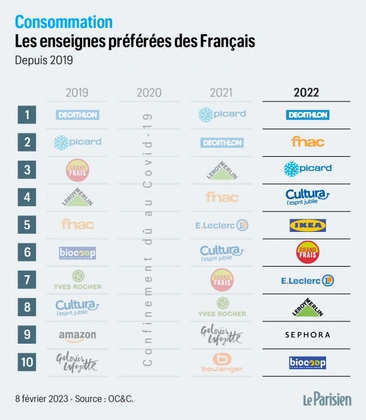
In English, “favorite brands of French people since 2019”
Let's see how Decathlon managed to cultivate this satisfaction and achieve a remarkable NPS.
Easy product access:
Decathlon has revolutionized the shopping experience by offering a wide range of high-quality sports products under one roof. This accessibility streamlines the purchasing process for customers, reducing friction and enhancing satisfaction.
Expert staff:
Decathlon employees are passionate about sports and capable of providing advice and recommendations tailored to the needs of customers. This personal expertise adds value and establishes a trustful connection with clients.
Commitment to quality:
Committed to delivering high-quality products at affordable prices. This assurance of quality reassures customers and strengthens their loyalty.
Listening approach:
Values customer feedback and uses it to continuously improve its products and services. Post-purchase surveys and open feedback channels enable the company to understand the changing needs of customers.
Customer service accessibility and friendliness:
Interactions with Decathlon's customer service are known for their efficiency and friendliness. Customers feel heard and supported, further strengthening their commitment to the brand.
In-store experience:
Stores are designed to offer an immersive experience. Customers can test products, receive advice, and participate in workshops, creating an atmosphere of learning and discovery.
Innovation and values adherence:
Constantly innovates to address emerging customer needs. The company also adheres to values of sustainability and social responsibility, which resonate with current customer concerns.
Technology utilization:
Integrates technological tools such as mobile applications to enhance the customer experience, provide useful information, and streamline the purchasing process.
5) Advanced use of NPS
Data segmentation
By breaking down responses into specific groups, data segmentation provides a more detailed insight into how different customer segments perceive your company. For instance, grouping by age, location, or purchasing behavior can unveil specific trends not visible in overall data.
Satisfaction/Importance matrix
The Satisfaction/Importance Matrix is a powerful tool for prioritizing attributes based on their impact on NPS. By assessing customer satisfaction relative to the importance they attach to each attribute, you can pinpoint key areas needing improvement or special attention.
Putting into practice
These advanced methods directly impact strategic decisions. For example, data segmentation enables personalized actions tailored to the specific needs of each segment. The Satisfaction/Importance matrix guides resources toward aspects that most influence overall satisfaction.
6) Implementing an NPS measurement system
- Step 1
Data collection: Collect NPS responses systematically through various channels like online surveys, emails, mobile apps, or even in-person interactions. Make sure to choose the most relevant channels for your target audience.
- Step 2
Result analysis: Once collected, analyzing the results becomes crucial. Examine both overall scores and specific customer comments. Identify trends, strengths, and areas for improvement. This analysis will guide you toward actionable insights.
- Step 3
Action plan based on results: NPS results are more than just numbers; they're the starting point for effective action. Create a robust action plan based on the insights you've extracted. Identify key areas where you can enhance the customer experience to positively impact NPS.
Implementing the plan
Execute the defined actions in your plan. This may involve staff training adjustments, product improvements, changes in return policies, etc. Monitor the progress of your actions and adjust the plan accordingly.
Communication with the clients
Execute the defined actions in your plan. This may involve staff training adjustments, product improvements, changes in return policies, etc. Monitor the progress of your actions and adjust the plan accordingly.
Customer communication
Keep your customers informed about the actions you're taking to enhance their experience. This demonstrates that you take their feedback seriously and are actively working towards their satisfaction.
7) Integrating emotional analysis into the NPS strategy
We tend to believe that our decisions are based on rational or analytical processing of our options. We like to think we're in control, that our evaluations lead us to make the right or best decision, and that we're not influenced by branding or advertisements. However, even if they sneak in very subtly, emotions are the primary drivers of the entire decision-making process. Decisions are simply emotional, not logical.
In reality, emotions greatly influence and, in many cases, even determine our buying decisions:
- Emotional reactions are 3000 times faster than rational thought.
- Emotional parts of the brain process sensory inputs 5 times faster than rational thought.
- The emotion-to-reason persuasion ratio is 24 to 1.
</aside>
Net Promoter Score & Q°Emotion
Q°emotion - Find the right insights with emotional data, increase NPS and conversion rate
Q°emotion is a bit like an emotions detective. It specializes in understanding customer emotions. By combining NPS information with what it knows about emotions, Q°emotion can tell an even more comprehensive story about customer experience. This helps businesses know not just what customers are saying, but also how they truly feel.
Integrating Q°emotion into NPS is like adding an emotional detection lens. Thanks to its ability to analyze emotions expressed by customers, Q°emotion enables a deeper understanding of the underlying reasons behind NPS scores. It can answer the crucial question: "Why do customers feel this way?" or unveil hidden elements in scores, such as positive emotions not reflected in numbers alone.
By combining NPS scores with Q°motion's emotional analysis, companies can make informed, targeted decisions. This collaboration provides a complete picture of the customer experience, helping businesses tailor their strategies to meet both emotional and practical customer needs.
8) Top 4 NPS tools
Several NPS tools are available on the market, but here are what we consider the top 4:
1) SurveyMonkey

- 20 years of survey expertise.
- 100+ customizable templates for creating surveys in minutes.
- The most popular survey software among Capterra customers.
- User-friendly, full range of features, and security.
- Customize survey appearance with themes, add logo and brand with paid plan.
- Collect responses via web links, emails, social posts, Facebook Messenger, QR codes, and more.
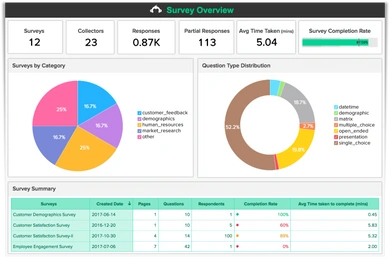
2) Survicate

- Solution focused on customer reactions for online businesses.
- Quickly create NPS surveys.
- Customize NPS surveys with brand-matching colors and CSS.
- Measure NPS via email, web page, app, and even Intercom messaging.
- Real-time NPS assessment tracking with date, score, and custom filters data, as well as survey channel.
- Share actionable feedback with other marketing and business tools through native integrations.
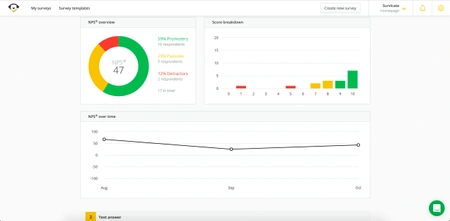
3) SatisMeter

- Streamlines automated tracking of customer feedback, enabling businesses to respond faster and improve customer service.
- Allows precise targeting of feedback based on product and customer segment.
- Enables identification of dissatisfied customers and resolution of their issues before they churn.
- Uses the Net Promoter System to measure customer loyalty and gather actionable insights in-app.
- Provides users a wide array of features for understanding and improving customer satisfaction (feedback collection, surveys, email, SMS...).
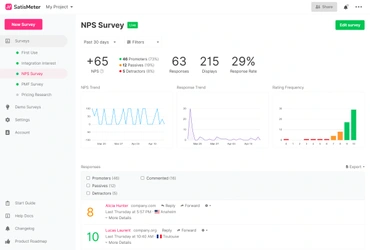
4) Q°emotion
Q°emotion, used in tandem with other NPS survey tools, provides a valuable emotional perspective for a better understanding of customer satisfaction.

- Semantic analysis to detect emotions expressed in NPS survey responses, going beyond mere numbers.
- Provides richer insights into the reasons behind NPS scores.
- Presents data in the form of graphs and visualizations that highlight dominant emotions associated with each NPS score.
- Helps businesses take more targeted actions to improve customer satisfaction.
- Enables continuous monitoring of customer satisfaction.
By using Q°emotion in conjunction with other tools, businesses can delve deeper into customer responses to NPS questions, gaining richer insights into customer emotions. This allows them to better meet customer needs and strengthen their customer relationships.
9) Conclusion
In exploring the Net Promoter Score (NPS) and its tools, we have highlighted the importance of understanding what your customers truly think. These tools are not just indicators but also trend revealers and essential guides for continuous improvement. Among these tools, Q°emotion stands out as a valuable ally in uncovering the hidden emotions behind NPS scores.
Ultimately, NPS is not just a concept; it's a driver of action. Use the data and insights obtained through these tools, including Q°emotion, to improve your business, build stronger relationships with your customers, and thrive in an ever-evolving competitive landscape.
Similar posts
How to improve customer retention and loyalty with emotional AI?
Published on September 25, 2024 - Updated on October 02, 2024
How to improve customer retention and build loyalty with Emotional AI In an increasingly competitive market, building customer loyalty is essential to ensure the long-term future of your business. Bu...
Voice assistants, facial emotional analysis and conversational data: essential tools for businesses
Published on September 09, 2024 - Updated on September 09, 2024
Voice assistants, facial emotional analysis and conversational data: essential tools for businesses Discover how facial, voice and conversational emotional analysis can improve understanding of cu...